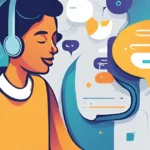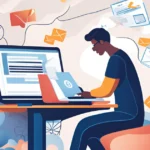Using ChatGPT to craft your emails can save time, enhance communication, and boost productivity. With the proper prompts and creativity, you can effortlessly generate personalized and professional email content.

This guide explores utilizing ChatGPT for effective email writing in various contexts, from personal notes to professional correspondence.
Why ChatGPT for Email Writing?
Finding effective ways to express yourself through emails is crucial in a world where communication is critical.
Enter ChatGPT, an AI language model that can assist you in drafting emails that are clear, concise, and tailored to your audience.
Whether you’re sending a quick note to a friend or a detailed proposal to a client, ChatGPT can help streamline the process.
Types of Emails ChatGPT Can Help With
- Personal Emails: ChatGPT can help you express your feelings with the right tone, from birthday wishes to heartfelt thank-you notes.
- Professional Emails: Cold outreach, follow-ups, and team updates become more manageable when an AI assistant guides you.
- Marketing Emails: Create compelling sales pitches, engaging newsletters, and event invitations that capture attention.
How to Effectively Use ChatGPT for Emails
Setting the Right Prompt
The first step in utilizing ChatGPT is crafting the correct prompt. Be specific about the content you need. For instance:
- Cold Outreach Email: “Write a concise and informal cold email to a sales lead.”
- Follow-Up Email: “Draft a professional follow-up email requesting a meeting.”
The more precise your instructions, the more tailored the output will be.
Iterating and Refining Responses
ChatGPT generates an initial draft based on your prompt. Feel free to edit and refine the text to suit your voice better. For example, if the generated email feels too formal, you can request a more casual tone.
Example Prompts
- Customer Support: “Write a response to a customer complaint about a defective product, apologizing and offering a refund.”
- Event Invitation: “Draft an invitation email for a corporate event, including date, time, and RSVP details.”
Tips for Optimizing Email Content

Subject Lines Matter
An engaging subject line is crucial for getting your emails opened. Use ChatGPT to brainstorm several options. For example, you can prompt: “Generate five catchy subject lines for a newsletter about productivity tips.”
Personalization is Key
Always aim to personalize your emails. Include the recipient’s name, specific references, and tailored messages to make them feel valued. You could say, “Add a personal touch by referencing our last conversation about project updates.”
Editing and Reviewing
While ChatGPT is highly effective, it’s essential to proofread the content before sending it. This helps ensure accuracy and appropriateness, maintaining a professional communication standard.
Everyday Use Cases and Prompts
- Handling Complaints: “Write an empathetic email addressing a customer complaint.”
- Project Updates: “Formulate an email to my team updating them on our project’s progress.”
- Feedback Requests: “Compose an email asking a colleague for feedback on a recent presentation.”
Limitations of Using ChatGPT
While ChatGPT is a powerful tool, it’s essential to be aware of its limitations. It may need to understand emotional nuances or specific contexts fully. Therefore, it’s best used as a supplementary tool rather than a complete replacement for human interaction.

Conclusion
ChatGPT is a valuable ally in streamlining your email communication. By leveraging its capabilities, you can craft emails that are professional and resonate with your audience. You’ll discover the best ways to utilize this AI tool effectively as you experiment with different prompts and styles.





